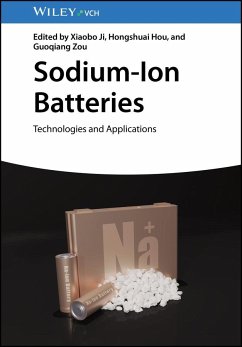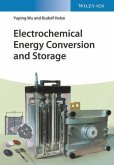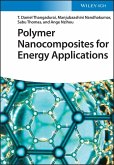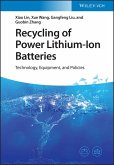Sodium-Ion Batteries
Technologies and Applications
Herausgegeben:Ji, Xiaobo; Hou, Hongshuai; Zou, Guoqiang
Sodium-Ion Batteries
Technologies and Applications
Herausgegeben:Ji, Xiaobo; Hou, Hongshuai; Zou, Guoqiang
- Gebundenes Buch
- Merkliste
- Auf die Merkliste
- Bewerten Bewerten
- Teilen
- Produkt teilen
- Produkterinnerung
- Produkterinnerung
This book systematically summarizes and condenses the development, directions, potential and core issues of sodium-ion batteries.
Andere Kunden interessierten sich auch für
![Rechargeable Organic Batteries Rechargeable Organic Batteries]() Yongzhu FuRechargeable Organic Batteries97,99 €
Yongzhu FuRechargeable Organic Batteries97,99 €![Electrochemical Energy Conversion and Storage Electrochemical Energy Conversion and Storage]() Yuping WuElectrochemical Energy Conversion and Storage60,99 €
Yuping WuElectrochemical Energy Conversion and Storage60,99 €![Polymer Nanocomposites for Energy Applications Polymer Nanocomposites for Energy Applications]() T. Daniel ThangaduraiPolymer Nanocomposites for Energy Applications139,00 €
T. Daniel ThangaduraiPolymer Nanocomposites for Energy Applications139,00 €![Alkaline Anion Exchange Membranes for Fuel Cells Alkaline Anion Exchange Membranes for Fuel Cells]() Alkaline Anion Exchange Membranes for Fuel Cells112,99 €
Alkaline Anion Exchange Membranes for Fuel Cells112,99 €![Recycling of Power Lithium-Ion Batteries Recycling of Power Lithium-Ion Batteries]() Xiao LinRecycling of Power Lithium-Ion Batteries125,00 €
Xiao LinRecycling of Power Lithium-Ion Batteries125,00 €![Flow Batteries, 3 Volume Set Flow Batteries, 3 Volume Set]() Flow Batteries, 3 Volume Set293,99 €
Flow Batteries, 3 Volume Set293,99 €![Electrocatalysis for Membrane Fuel Cells Electrocatalysis for Membrane Fuel Cells]() Electrocatalysis for Membrane Fuel Cells126,99 €
Electrocatalysis for Membrane Fuel Cells126,99 €-
-
-
This book systematically summarizes and condenses the development, directions, potential and core issues of sodium-ion batteries.
Produktdetails
- Produktdetails
- Verlag: Wiley-VCH
- Artikelnr. des Verlages: 1135061 000
- 1. Auflage
- Seitenzahl: 368
- Erscheinungstermin: 6. Dezember 2023
- Englisch
- Abmessung: 248mm x 174mm x 23mm
- Gewicht: 852g
- ISBN-13: 9783527350612
- ISBN-10: 3527350616
- Artikelnr.: 67728997
- Herstellerkennzeichnung
- Wiley-VCH GmbH
- Boschstraße 12
- 69469 Weinheim
- wiley-vch@kolibri360.de
- Verlag: Wiley-VCH
- Artikelnr. des Verlages: 1135061 000
- 1. Auflage
- Seitenzahl: 368
- Erscheinungstermin: 6. Dezember 2023
- Englisch
- Abmessung: 248mm x 174mm x 23mm
- Gewicht: 852g
- ISBN-13: 9783527350612
- ISBN-10: 3527350616
- Artikelnr.: 67728997
- Herstellerkennzeichnung
- Wiley-VCH GmbH
- Boschstraße 12
- 69469 Weinheim
- wiley-vch@kolibri360.de
Xiaobo Ji, Associate Dean; Professor and Doctoral Supervisor of Central South University. He received a Ph.D. from Oxford University and later did post-doctoral research at MIT. His main research fields include new energy materials and devices and advanced energy storage technology. He has published more than 280 SCI papers in international journals such as Advanced Materials, Angewandte Chemie, and has been cited more than 16,000 times, with an H index of 68. 52 Chinese invention patents have been authorized to him.
1 INTRODUCTION
1.1 Overview
1.2 The birth and development of sodium-ion batteries
2 CHARACTERISTIC OF SODIUM ION BATTERIES
2.1 Basic Features
2.2 Working Principle
2.3 Concepts and Equations
2.4 Structural Composition
3 CATHODE MATERIALS OF SIBS
3.1 Polyanion Cathode
3.2 Oxide Cathode
3.3 Prussian Blue and their Analogues
3.4 Perovskite Transition Metal Fluorides
3.5 Organic Cathode
4 ANODE MATERIALS OF SODIUM ION BATTERIES
4.1 Carbon-based Anode
4.2 Titanium-based Anode
4.3 Conversion Anode
4.4 Metal/Alloy Anode
5 ELECTROLYTE, SEPARATOR, BINDER AND OTHER DEVICES OF SODIUM ION BATTERIES
5.1 Organic Liquid Electrolytes
5.2 Solid State Electrolytes
5.3 Separator
5.4 Binder
5.5 Conductive Agent
5.6 Current Collector
6 ADVANCED CHARACTERIZATION TECHNIQUES AND THEORETICAL CALCULATION
6.1 Imaging and Microscopy
6.2 Synchrotron Radiation X-Ray Diffraction Technique
6.3 Synchrotron Radiation X-Ray Absorption Spectroscopy Technique
6.4 Solid-state Nuclear Magnetic Resonance Spectroscopy
6.5 Electrochemical Test Techniques
6.6 Other Characterization Techniques
6.7 Theoretical Calculation
7 PRACTICAL APPLICATION OF SIBS
7.1 Introduction
7.2 Commercial Sodium Battery
7.3 Design and Manufacture Process of SIBs
7.4 Presodiation Techniques
7.5 Performances Test and Failure Analysis
7.6 Commercial Application and Future Perspectives
1.1 Overview
1.2 The birth and development of sodium-ion batteries
2 CHARACTERISTIC OF SODIUM ION BATTERIES
2.1 Basic Features
2.2 Working Principle
2.3 Concepts and Equations
2.4 Structural Composition
3 CATHODE MATERIALS OF SIBS
3.1 Polyanion Cathode
3.2 Oxide Cathode
3.3 Prussian Blue and their Analogues
3.4 Perovskite Transition Metal Fluorides
3.5 Organic Cathode
4 ANODE MATERIALS OF SODIUM ION BATTERIES
4.1 Carbon-based Anode
4.2 Titanium-based Anode
4.3 Conversion Anode
4.4 Metal/Alloy Anode
5 ELECTROLYTE, SEPARATOR, BINDER AND OTHER DEVICES OF SODIUM ION BATTERIES
5.1 Organic Liquid Electrolytes
5.2 Solid State Electrolytes
5.3 Separator
5.4 Binder
5.5 Conductive Agent
5.6 Current Collector
6 ADVANCED CHARACTERIZATION TECHNIQUES AND THEORETICAL CALCULATION
6.1 Imaging and Microscopy
6.2 Synchrotron Radiation X-Ray Diffraction Technique
6.3 Synchrotron Radiation X-Ray Absorption Spectroscopy Technique
6.4 Solid-state Nuclear Magnetic Resonance Spectroscopy
6.5 Electrochemical Test Techniques
6.6 Other Characterization Techniques
6.7 Theoretical Calculation
7 PRACTICAL APPLICATION OF SIBS
7.1 Introduction
7.2 Commercial Sodium Battery
7.3 Design and Manufacture Process of SIBs
7.4 Presodiation Techniques
7.5 Performances Test and Failure Analysis
7.6 Commercial Application and Future Perspectives
1 INTRODUCTION
1.1 Overview
1.2 The birth and development of sodium-ion batteries
2 CHARACTERISTIC OF SODIUM ION BATTERIES
2.1 Basic Features
2.2 Working Principle
2.3 Concepts and Equations
2.4 Structural Composition
3 CATHODE MATERIALS OF SIBS
3.1 Polyanion Cathode
3.2 Oxide Cathode
3.3 Prussian Blue and their Analogues
3.4 Perovskite Transition Metal Fluorides
3.5 Organic Cathode
4 ANODE MATERIALS OF SODIUM ION BATTERIES
4.1 Carbon-based Anode
4.2 Titanium-based Anode
4.3 Conversion Anode
4.4 Metal/Alloy Anode
5 ELECTROLYTE, SEPARATOR, BINDER AND OTHER DEVICES OF SODIUM ION BATTERIES
5.1 Organic Liquid Electrolytes
5.2 Solid State Electrolytes
5.3 Separator
5.4 Binder
5.5 Conductive Agent
5.6 Current Collector
6 ADVANCED CHARACTERIZATION TECHNIQUES AND THEORETICAL CALCULATION
6.1 Imaging and Microscopy
6.2 Synchrotron Radiation X-Ray Diffraction Technique
6.3 Synchrotron Radiation X-Ray Absorption Spectroscopy Technique
6.4 Solid-state Nuclear Magnetic Resonance Spectroscopy
6.5 Electrochemical Test Techniques
6.6 Other Characterization Techniques
6.7 Theoretical Calculation
7 PRACTICAL APPLICATION OF SIBS
7.1 Introduction
7.2 Commercial Sodium Battery
7.3 Design and Manufacture Process of SIBs
7.4 Presodiation Techniques
7.5 Performances Test and Failure Analysis
7.6 Commercial Application and Future Perspectives
1.1 Overview
1.2 The birth and development of sodium-ion batteries
2 CHARACTERISTIC OF SODIUM ION BATTERIES
2.1 Basic Features
2.2 Working Principle
2.3 Concepts and Equations
2.4 Structural Composition
3 CATHODE MATERIALS OF SIBS
3.1 Polyanion Cathode
3.2 Oxide Cathode
3.3 Prussian Blue and their Analogues
3.4 Perovskite Transition Metal Fluorides
3.5 Organic Cathode
4 ANODE MATERIALS OF SODIUM ION BATTERIES
4.1 Carbon-based Anode
4.2 Titanium-based Anode
4.3 Conversion Anode
4.4 Metal/Alloy Anode
5 ELECTROLYTE, SEPARATOR, BINDER AND OTHER DEVICES OF SODIUM ION BATTERIES
5.1 Organic Liquid Electrolytes
5.2 Solid State Electrolytes
5.3 Separator
5.4 Binder
5.5 Conductive Agent
5.6 Current Collector
6 ADVANCED CHARACTERIZATION TECHNIQUES AND THEORETICAL CALCULATION
6.1 Imaging and Microscopy
6.2 Synchrotron Radiation X-Ray Diffraction Technique
6.3 Synchrotron Radiation X-Ray Absorption Spectroscopy Technique
6.4 Solid-state Nuclear Magnetic Resonance Spectroscopy
6.5 Electrochemical Test Techniques
6.6 Other Characterization Techniques
6.7 Theoretical Calculation
7 PRACTICAL APPLICATION OF SIBS
7.1 Introduction
7.2 Commercial Sodium Battery
7.3 Design and Manufacture Process of SIBs
7.4 Presodiation Techniques
7.5 Performances Test and Failure Analysis
7.6 Commercial Application and Future Perspectives








